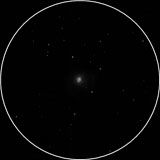
| MESSIER 80 |
|---|
RA: |
16h 17m 00s |
|
DEC: |
-22° 59' 00'' |
|
Type: |
Globular cluster |
|
NGC: |
6093 |
|
Magnitude: |
7.20 |
|
Surface brightness : |
11.00 |
|
Apparent dimensions : |
5'x5' |
|
Distance: |
32,600 ly |
|
Globular cluster M80 was one of the original discoveries of Charles Messier, who found it on January 4, 1781, and cataloged it as a "Nebula without a star, .. resembling the nucleus of a comet." William Herschel was the first to resolve it (before 1785), and found it was "one of the richest and most compressed clusters of small stars I remember to have seen." M80 is a fine 7th mag globular. Its 10' angular diameter corresponds to roughly 95 light years linear dimension at its distance of 32,600 light years. Its appearance resembles very much that of a faint comet without tail. This dense stellar swarm contains several 100,000s of stars, held together by their mutual gravitational attraction. It is one of the densest globulars in our Milky Way Galaxy. Detail investigations discovered large number of blue stars so called "Blue Stragglers." Blue stars should not exist in globular clusters since they have to short lifespan. It is thought that Blue Stragglers are created in collisions of smaller stars. Their large number in M80 indicates an exceptionally high stellar collision rate in the core of this globular cluster. On May 21, 1860, a nove occurred in M80, completely changing the appearance of this globular cluster for some days. This nova, also designated T Scorpii was discovered by Auwers at Berlin, had mag 7.0 on May 21 and 22, and faded to mag 10.5 on June 16. It was independently seen by Pogson. It was reported that Pogson had seen a rebrightening in early 1864, but this appears improbable, as nobody else could confirm this notion. The maximum brighteness of this nova corresponds to an absolute magnitude of about -8.5, if it was a cluster member. At its maximum, the nova was considerably brighter as whole cluster! M80, though not very conspicuous, can be located quite easily as it is situated almost exactly half-way between Antares (Alpha Scorpii) and Graffias (Beta Scorpii), just below the declination parallel of Dschubba (Delta Scorpii). It is seen as a bright but small, round ball with brighter nucleus; its surface brightness decreases to the outer regions. Messier determined a diameter of 2 arc min, but better moderate-sized amateur telescopes will show it as a mottled, nebulous object of size 3-5 arc mins, at best very poorly resolved. A better resolution into stars requires larger aperture telescopes. |
||
VEDRAN VRHOVAC© 2006.-2007. |
